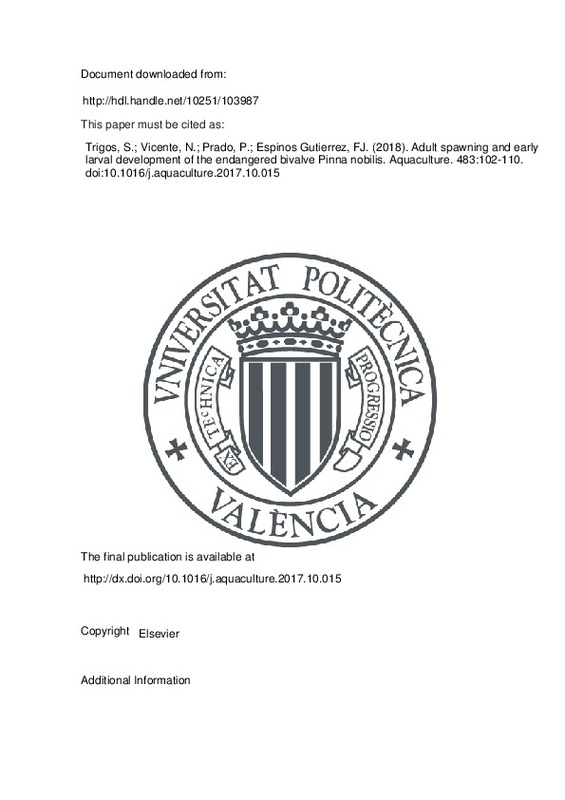JavaScript is disabled for your browser. Some features of this site may not work without it.
Buscar en RiuNet
Listar
Mi cuenta
Estadísticas
Ayuda RiuNet
Admin. UPV
Adult spawning and early larval development of the endangered bivalve Pinna nobilis
Mostrar el registro sencillo del ítem
Ficheros en el ítem
| dc.contributor.author | Trigos, Sergio
|
es_ES |
| dc.contributor.author | Vicente, Nardo
|
es_ES |
| dc.contributor.author | Prado, Patricia
|
es_ES |
| dc.contributor.author | Espinos Gutierrez, Francisco Juan
|
es_ES |
| dc.date.accessioned | 2018-06-14T04:23:11Z | |
| dc.date.available | 2018-06-14T04:23:11Z | |
| dc.date.issued | 2018 | es_ES |
| dc.identifier.issn | 0044-8486 | es_ES |
| dc.identifier.uri | http://hdl.handle.net/10251/103987 | |
| dc.description.abstract | [EN] The development of aquaculture activities has posed an alternative solution for the preservation of some overexploited shell¿sh ¿sheries worldwide. In the same way, endemic Mediterranean bivalves such as Pinna nobilis, highly threatened by habitat loss and coastal pollution, could found in aquaculture a solution for preserving the continuity of the species. Given the endangered status of the species, the biological and ecological processes regulating natural populations have been well studied, but there are still important knowledge gaps preventing the development of viable arti¿cial cultures. This study describes for the ¿rst time the larval development of P. nobilis (from fertilization until pediveliger larval stages) in captivity conditions. Moreover, di¿erent rearing tanks of 5, 16 and 80 L, larvae density from 1 to 600 larvae mL¿1, light conditions, food doses, were tested in order to establish the bases for the optimal rearing of the species and provide a source of individuals for restoring ¿eld populations. Results showed that 16 L tanks with a concentration of 2 larvae mL¿1, constant temperature of 21 °C, 12/12 h photoperiod and fed with an ¿optimal¿ mixture of 25 cells per ¿L of Chaetoceros calcitrans + 33.3 cells per¿L ofPavlova lutheri + 100 cells per¿L ofIsochrysis galbana¿ appear to be the best conditions to rearlarvae ofP. nobilis.Di¿erentcaptivity conditions such as loweror highertank volume, larvae density, or food doses; light privation did not report better results for larval development. | es_ES |
| dc.description.sponsorship | The present study was financed by the Caisse d'Epargne Cote d'Azur. We are also grateful to the research crew of the Institut Oceanographique Paul Ricard and the Catholic University of Valencia for their technical support and help collecting and maintaining fan mussels. Special thanks to the reviewers for their constructive and necessary suggestions. | en_EN |
| dc.language | Inglés | es_ES |
| dc.publisher | Elsevier | es_ES |
| dc.relation.ispartof | Aquaculture | es_ES |
| dc.rights | Reserva de todos los derechos | es_ES |
| dc.subject | Pinna nobilis | es_ES |
| dc.subject | Conservation | es_ES |
| dc.subject | Larvae Development | es_ES |
| dc.subject | Rearing | es_ES |
| dc.subject | Captivity | es_ES |
| dc.subject.classification | BIOLOGIA ANIMAL | es_ES |
| dc.subject.classification | PRODUCCION ANIMAL | es_ES |
| dc.title | Adult spawning and early larval development of the endangered bivalve Pinna nobilis | es_ES |
| dc.type | Artículo | es_ES |
| dc.identifier.doi | 10.1016/j.aquaculture.2017.10.015 | es_ES |
| dc.rights.accessRights | Abierto | es_ES |
| dc.contributor.affiliation | Universitat Politècnica de València. Departamento de Ciencia Animal - Departament de Ciència Animal | es_ES |
| dc.description.bibliographicCitation | Trigos, S.; Vicente, N.; Prado, P.; Espinos Gutierrez, FJ. (2018). Adult spawning and early larval development of the endangered bivalve Pinna nobilis. Aquaculture. 483:102-110. doi:10.1016/j.aquaculture.2017.10.015 | es_ES |
| dc.description.accrualMethod | S | es_ES |
| dc.relation.publisherversion | http://dx.doi.org/10.1016/j.aquaculture.2017.10.015 | es_ES |
| dc.description.upvformatpinicio | 102 | es_ES |
| dc.description.upvformatpfin | 110 | es_ES |
| dc.type.version | info:eu-repo/semantics/publishedVersion | es_ES |
| dc.description.volume | 483 | es_ES |
| dc.relation.pasarela | S\361709 | es_ES |
| dc.contributor.funder | Caisse d'epargne Côte d'Azur |







![[Cerrado]](/themes/UPV/images/candado.png)

